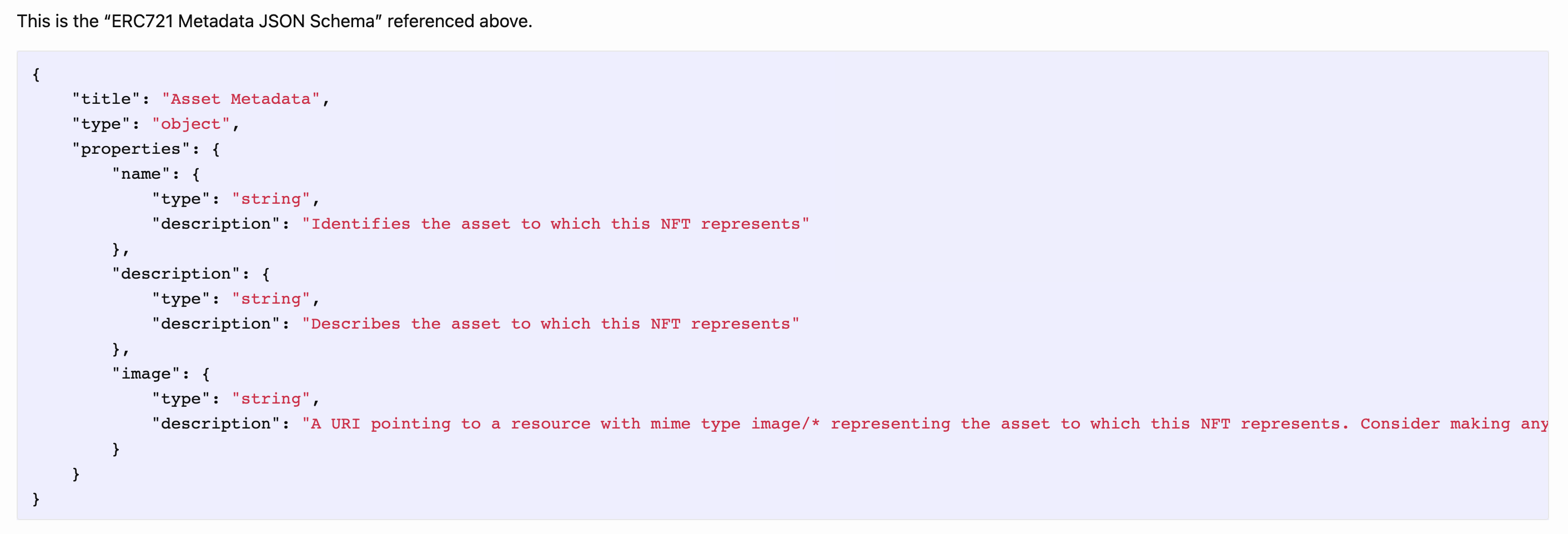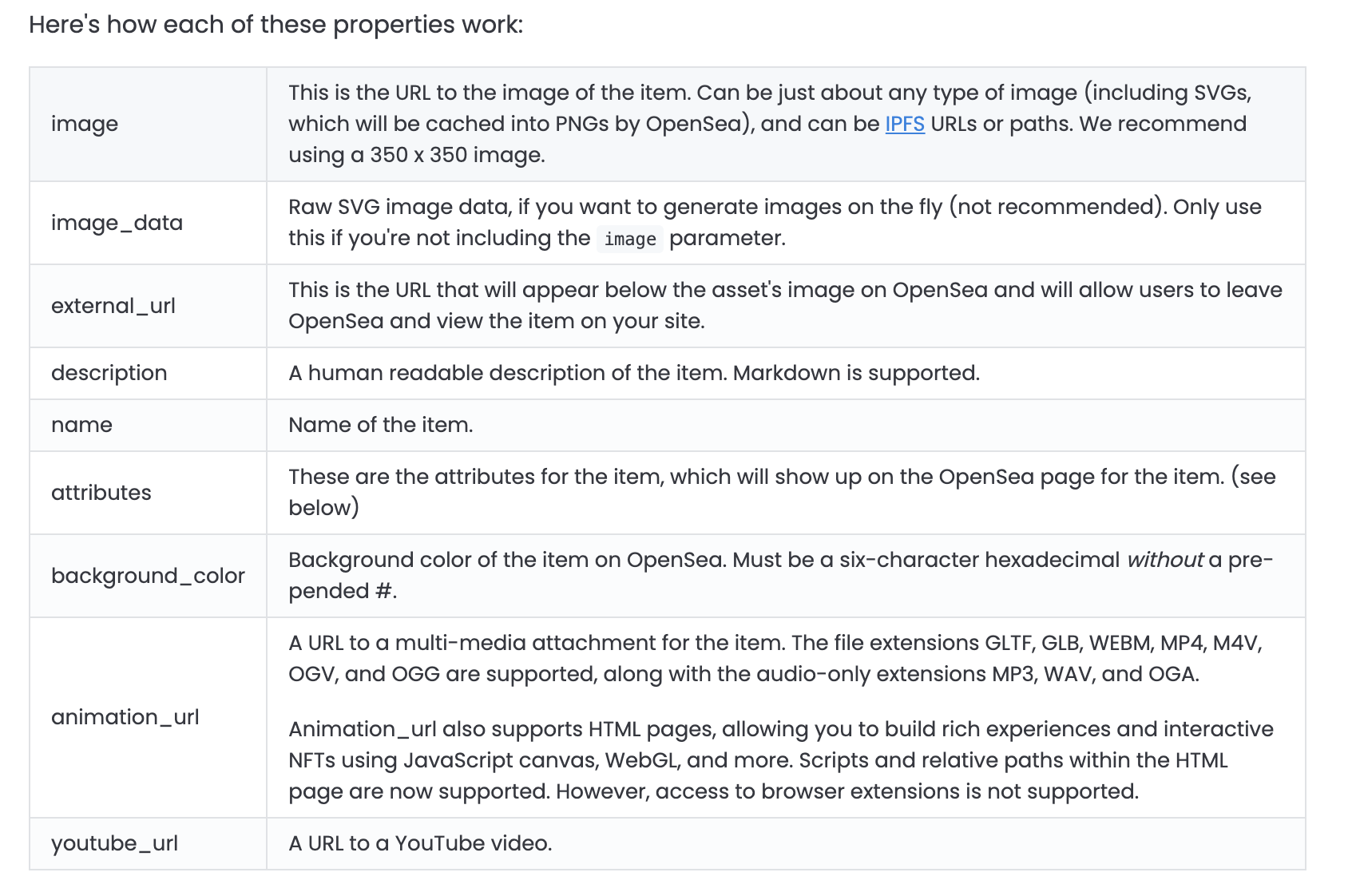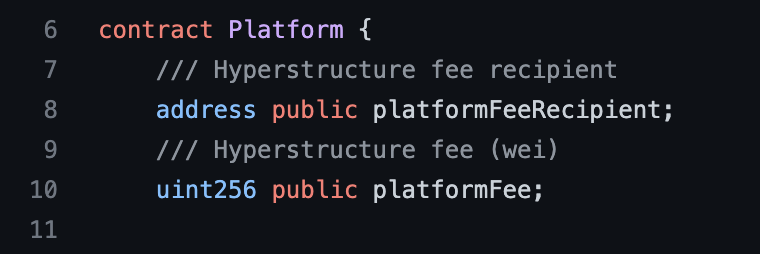music nfts have emerged as a subset of the nft ecosystem focused on music metadata. There are a few different origins for most music nfts:
The lifecycle of a music nft is pretty standard:
Metadata is the foundation
What differentiates a music nft from any other ERC721 token? Metadata. Marketplaces, like OpenSea & Zora, display your token by calling the tokenURI method defined in the EIP721 standard:

And the EIP721 metadata standard only includes 3 attributes
namedescriptionimage

That’s it. From here we get more opinionated. Most people want more data than just name, description & image. But, that’s all that’s defined in the Ethereum standard, how would we add more attributes?
OpenSea standardized metadata
OpenSea is the biggest nft marketplace. As a result, when people create nfts, they’ll inevitably ask:
- how does my nft look in OpenSea?
OpenSea’s Metadata Standards expand upon the EIP721 standard by indexing the following additional attributes:
image_dataexternal_urlattributesbackground_coloranimation_urlyoutube_url

OpenSea is a very generic marketplace. It’s clear the tokenURI method is important for representing non-funglible tokens in the metaverse. However, are the standards defined by OpenSea sufficient to represent music nfts?
Music NFTs
How will music nfts be consumed in the metaverse? We don’t need to speculate, we can already see music nfts being indexed and integrated into platforms such as SpinAmp. This is the ideal vision for music, free to consume across the metaverse and valuable to own. SpinAmp is just one example, but demonstrates the need for standardized music metadata.
in the metaverse, music nfts will only be as good as their metadata.
Back to the original question: What differentiates a music nft from any other ERC721 token?
The Value of Platforms
If you’re reading this article, you’re probably interested in migrating off platforms onto your own smart contracts. While we often demonize platforms as centralizing forces in a decentralized ecosystem, platforms add a lot of value to the music nft ecosystem. A few examples:
- onboarding - platforms make it easy for new musicians.
- standardizing - platforms create industry standards.
When I was an engineer at mint songs, we worked closely with Catalog to defined a standard music metadata schema to serve as the foundation for music nfts in the metaverse:
This new standard expands upon OpenSea’s standards to include attributes such at:
genrebpmlosslessAudiomimeType- 30+ other attributes.
This is just the beginning. Now that platforms have defined a baseline for music metadata, we, as a decentralized community get to decide:
- is this metadata sufficient?
- how can we improve music metadata further?
- how can we start at our metaverse expectations of how music nfts will feel and work backwards?
- how can we decentralize access to the creation of music nfts?
The First Music Hyperstructure: Metadata
Let’s summarize the key points so far:
- metadata is the foundation for a music nft.
- there is no hyperstructure to support the minting / indexing of music nfts in a decentralized way.
To help make it easy for music nft projects to add the standardized music metadata, I released an npm package:
This was my starting place, now the question is, how can we make it as easy as projects to plug into the standard metadata for music nft:
- minting
- indexing
This first post is going to outline the initial hyperstructure we built:
music nft hyperstructure: minting nfts with music metadata.
From here on out many of the ideas are based on the original Hyperstructures article. Jacob given me a lot of inspiration here and I wanna tip my hat to the foundation he created. I highly recommend reading the original to get a deeper understanding of Hyperstructures.
- it’s worth noting the music hyperstructure is built on top of Zora V3.
- all music nfts are listed on Zora V3 for increased discoverability / indexing.
Definition
Hyperstructure - Crypto protocols that can run for free and forever, without maintenance, interruption or intermediaries (Jacob). Hyperstructures take the form of protocols that run on blockchains. Something can be considered a hyperstructure if it is:
- Unstoppable: the protocol cannot be stopped by anyone. It runs for as long as the underlying blockchain exists.
- Free: there is a 0% protocol wide fee and runs exactly at gas cost.
- Valuable: accrues value which is accessible and exitable by the owners.
- Expansive: there are built-in incentives for participants in the protocol.
- Permissionless: universally accessible and censorship resistant. Builders and users cannot be deplatformed.
- Positive sum: it creates a win-win environment for participants to utilize the same infrastrastructure.
- Credibly neutral: the protocol is user-agnostic.
Unstoppable
Traditional music infrastructure like record labels and distribution platforms require a trusted intermediary to maintain and operate it - without it the infrastructure will degrade and/or stop operating altogether. These operators are organizations, either privately owned or state controlled—and require both profits, labor and/or subsidies to serve their purpose over time.
Even platforms like Catalog / Mint Songs / Sound require a whitelist to publish music nfts on their contracts. These whitelists typically require manual updates. If these platforms die (or funding runs dry), their infrastructure could, in theory, become unusable.
The music hyperstructure has been deployed on 4 different chains (including ETH & Polygon Mainnet) & requires zero maintenance. It will run, unstoppably, as long as Ethereum is producing blocks.
See the full list of verified contracts here.

Free
Hyperstructures can be simultaneously free forever to utilize and extremely valuable to own. This is possible because of their unstoppability. There is no cost to maintain and keep the protocol operational forever. Once deployed, it will work exactly as it’s designed with no degradation. Gas costs are still paid by the user of the protocol.
The music hyperstructure is:
- free to utilize: musicians can mint music nfts for free, with zero platform fees.
- valuable to own: Record labels / distributors and other music nft organizations (ChillPill / Squad of Knights / VolDAO) hold a lot of value by aggregating music nfts in their, curated, music nft ecosystem.

Valuable
Music hyperstructures can simultaneously be free to use and also extremely valuable to own and govern.
I work with a lot of music nft projects. When 10k pfp projects, focused on music, make promises, they often include roadmaps including:
- exclusive music nft minting for token holders.
Before, these music nft projects had to hire an engineer and spend multiple weeks building out these smart contracts / minting UI. By using the music hyperstructure nft projects like Squad of Knights & Chill Pill can not only add minting quickly, but can easily set a platformFee to drive financial value back to the projects who are onboarding more musicians into the music nft ecosystem.
- free to use here.
- valuable to own by
- calling
createCurationto deploy your custom factory and addplatformFee. - aggregating music nft data.
- governing the curation mechanism.
- calling

Expansive fees
Music hyperstructures have Expansive Fees—built-in incentives that can be utilized by anyone adding value in a codified manner on top of the protocol.
There are 2 sets of expansive fees built into the music hyperstructure:
platformFee- new fee type. ✨- paid to the platform minting the music nft.
findersFeeinherited from Zora V3.- paid to the finder of a buyer.

Permissionless
Music hyperstructures do not contain permissions. There are 2 implications of this:
- gatekeepers - everyone can use it without prejudice.
- upgrades - no upgrades can be made to the underlying core principles.
The music hyperstructure is fully permisionless at the base level. Curators / platforms / musicians can use the music hyperstructure to create custom curation mechanisms. This enable permissionless minting / curation.
curation is a public good.

Credibly Neutral
The codebases powering music hyperstructures are totally open. No need to give credit when you integrate music hyperstructures into your own apps. The key distinction between permissionless & credibly neutral is:
- permissionless - ability to use the protocol.
- credibly neutral - no need to credit original writers.
I like CC0 as a foundation for credible-neutrality:
CC0 enables scientists, educators, artists and other creators and owners of copyright- or database-protected content to waive those interests in their works and thereby place them as completely as possible in the public domain, so that others may freely build upon, enhance and reuse the works for any purposes without restriction under copyright or database law. - source
Wanna use a music hyperstructure? You don’t need to ask permission:
- use it now.
- fork the code.
- build your own. ✨
Positive-sum
Most music ecosystems are extractive:
- Record Labels
- Streaming Platforms
By being free forever, there’s no incentive to fork the exact functionality. However, there is value in creating a differentiated solution with additional functionality.
- Fees allow participants to directly profit by driving value to the ecosystem.
By being unstoppable, there’s no risk of hyperstructures rug-pulling you.
- use the system without operational risks from building or maintaining it.
By being permissionless, the rules of music are guaranteed to be unchanging, forever.
- create music with a standardized set of unchanging rules.
Combine these to get a vibrant ecosystem of independent actors. Each competing in their own self-interest, to create a cohesive, sustainable, and profitable music community for all participants.
Building a Hyperstructure
Taking Jacob’s original version of a hyperstructure, here’s what we built:
- Hyperstructures are made to power millions of interfaces, not just one: the music nft hyperstructure is generic. Made to be used by 10k nft projects, Music NFT platforms, and individual musicians.
- Use fees as a way to expand the ecosystem, not extract from it: The demo app, found here, shows an implementation of the protocol without fees: 100% free for musicians & curators. Other participants can turn fees on to directly profit from the value they’re adding to the ecosystem.
- Take a protocol-first building approach: 👁💛🧑💻 (we love coders) you can find all code to get started using the music hyperstructure here:
- UI. 🌈
- Smart Contracts. 📜
- npm package. 📦
- Building liquidity: liquidity is built at the curator / creator level. When you use the music hyperstructure, you create a creator-owned smart contract allowing you to build your own liquidity of music nfts.
- Ownership where possible, governance where only necessary: creators own their contracts. There is ZERO ownership mechanisms in the underlying hyperstructure. The goal with music nft hyperstructures is a decentralized, composable, music ecosystem. We push all ownership to creators & curators.
- There is a long build cycle: costs are high to deploy additional versions of the music hyperstructure on Ethereum mainnet. Changes will have long design periods, multiple iterations on L2 blockchains, and multiple rounds of community-led feedback before changes are deployed to Ethereum mainnet.
Societal Infrastructure
Given the centralized nature of the music ecosystem in its current form, as well as the decentralized and unstopable nature of blockchains, we have the opportunity to create a more equitable system for creators. We have the opportunity to build a system that:
- gives creators ownership of their art.
- ERC721 standardizes asset ownership.
- music metadata standardizes the industry.
- increases discoverability without sacrificing ownership.
- speeds up payment rails.
- no more waiting months to get paid out by streaming platforms.
Every single piece of music technology will be rebuilt, from the ground up, with these new rules in mind. No more extractive behaviors. More opportunities for musicians to earn a sustainable living from their art, as well as growing opportunities for other actors to participate in financially productive ways as well.
💿 viva la musica 🫡
References
-
hyperstructures - by jacob.
-
CC0 - by creative commons.
-
How to Get Rich - by naval.
-
EIP721 - by William Entriken, Dieter Shirley, Jacob Evans, Nastassia Sachs.
-
OpenSea Metadata Standards - by OpenSea.
-
npm i onchain-music-metadata - by sweetman.eth.
-
music metadata standard - by Brett Henderson.